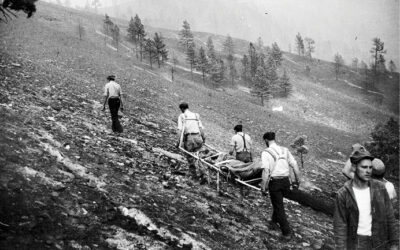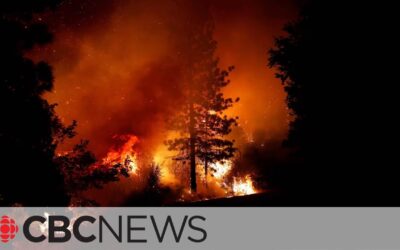As they drove along Newfound Gap, Salansky spotted a black cloud
Matt Lakin, Knoxville News Sentinel
The bare rock cracked and crumbled beneath his fingertips.
Every so often, a handhold or footing gave way, sending bits of stone clattering down the mountainside to the rocks nearly a mile below, and doubts racing through his mind.
Greg Salansky, fire management officer for the Great Smoky Mountains National Park, looked up, squinting through the smoke. Almost to the top – too late to turn back now. He hadn’t come out for this.
He headed out with another park firefighter, April Deming, that afternoon to check on a call about a car fire on Newfound Gap Road. They’d been on their way when a dispatcher canceled the call just before 5:30 p.m.
It was Nov. 23, the day before Thanksgiving, but the day didn’t end with that call. As they drove along Newfound Gap, Salansky spotted a black cloud – smoke, rising from a nearby peak to the north.
That summer had proved one of the driest on record, leading to a busy fire season all through fall. The pair pulled off-road and set out on foot to investigate, leaves and grass crunching under their feet.
The twin pinnacles of the Chimney Tops stand nearly 4,800 feet above their namesake trail, one of the most popular hiking spots in the park. By the time Salansky and Deming finished the 2-mile trek uphill to the foot of the peaks, dusk had turned to dark – but not too dark to make out the column of smoke rising from the northeast slope of the northernmost peak.
The slope today looks rocky and forbidding, burned bald over the days that followed. That November night it looked less barren but no less stark, just as steep but covered in grass and shrubbery, undergrowth and deadfall. Duff – the woodland debris that piles up over the seasons on the forest floor – lay 3 feet deep in places.
At the trail’s end, signs warned against going any farther. What lay ahead – a shriveled, unkempt footpath – hadn’t been officially open for decades, not since a 16-year-old on a church trip fell more than 350 feet to his death in August 1994.
Stopping there sounded like the right idea to Deming. They’d located the fire. Couldn’t it keep until morning?
No, Salansky decided. Drought had made even small fires in remote spots risky. Just last week he’d gotten an email from his boss, the regional fire officer for the Southeastern U.S., warning “the big one” could be just around the corner.
He dropped his pack and went on alone.
He was alone, he could barely see, and he figured he ‘shouldn’t even be here.’
The Chimney Tops slopes make for rough going even in daylight. Loose duff gives way underfoot. Roots and vines twist and tangle into natural tripwires along narrow cliffs.
A 60 percent incline – all but straight up – means a climb mostly by hand. Near the summit, the undergrowth yields to bare, jagged Anakeesta slate that can crumble at the touch.
At the top, an east wind scattered embers across the rocks. Salansky clambered down to the gap between the pinnacles and up the north peak toward the glow of the fire.
He peered through darkness and thickening smoke to guess at the size – an acre? No, a little less. Flames had burrowed deep in the duff, slowly making their way down the slope against the wind.
He’d brought nothing but a small hand tool. He scrabbled at the ground, trying to brush away enough leaves and duff to start a firebreak.
Second thoughts kicked in. He was alone. He could barely see. A sheer drop awaited him on either side.
“I figured out I shouldn’t even be here,” Salansky later told a private tour group, as reported by the blog Wildfire Today – the only time he’s talked publicly about the fire. “So I thought, I’m done. There’s nothing I can do with it. … It’s not safe. So I bailed off and tied in with April, who was my safety since she was smart enough not to go where I went.”
You were right, he told her. It can wait. We’ll come back in the morning.
Professor warned years ago that Smokies had become a half-million-acre tinderbox. But he was dismissed.
Forest landscapes like those seen from the Chimney Tops made the Smokies into America’s most-visited national park.
Fire made the forests.
Some fires erupted naturally from lightning strikes; more often, from the hand of man. The Cherokee routinely burned along the mountaintops and valleys. White settlers who crossed the Appalachians followed their example.
Flames stripped away undergrowth, opening paths and clearing views for hunters, and unlocked nutrients in the soil.
“When you burn, that’s what forests want,” said Henri Grissino-Mayer, a professor of geography at the University of Tennessee. “That rejuvenates the forest. Burn it in the fall, and it comes back in the spring, lush and green. People think the Great Smoky Mountains got their name because of the beautiful, wispy fog on the mountaintops. No! They got that name because for most of their history, the Smokies were on fire.”
Grissino-Mayer has spent the past two decades studying the rings of trees in the park and surrounding Southeastern forests. The scars he and his students found tell a story of one fire after another, a cycle of about one blaze every five to 10 years.
That fiery pattern sputtered out with the creation of the Great Smoky Mountains National Park in 1934. The conservationist mentality of the time doused fires at the first flicker, with rangers focused on restoring the mountains to a pristine Garden of Eden that scholars now doubt ever existed.
The park system finally began conducting controlled burns in the 1990s – too little, too late.
Grissino-Mayer began warning as early as 2001 the park had become a half-million-acre tinderbox, waiting for an excuse to ignite. Park officials pooh-poohed the notion.
“There have been no major fires since 1934,” the professor said. “We have much higher tree densities. We have shrubs choking the understory – grasses, twigs, needles, leaves, logs, branches, everything on the forest floor. That’s all fuel, and it’s accumulated for 80 years now.
“The tree rings are telling us: Fire has to come back to this ecosystem. Fire will come back. That’s what nature does. Nature burns.”
There were 2 options: Fight the mountaintop fire or hope it burned itself out.
Dawn comes later to the mountains in fall. Salansky met four firefighters that Thanksgiving morning at 8 for the hike back to the Chimney Tops. Most of the park staff was off for the holiday.
This time three firefighters balked at the final climb. One joined Salansky on the way up.
Back on the north peak, they found the fire a little larger than when he left it. The wind had settled down. Damp ground suggested a few drops of rain might have fallen overnight.
A handful of matches lay scattered across the rock crevices.
Duff burns at a slow smolder, like a fine cigar. The pair scanned the slope – no signs of large flames.
The last time fire broke out on the Chimney Tops had been two weeks earlier near the trail’s end. Crews quickly dug a containment line and reported it out three days later with barely a quarter-acre burned.
That wouldn’t happen this time. The cliffs made that impossible. Salansky had spent 30 years as a ranger with the National Park Service and the U.S. Forest Service. Even he didn’t feel comfortable up here.
Salansky and his partner climbed down to talk with the three who’d stayed behind. He saw two options: Fight the fire on the mountaintop or close the trail, wait and hope the flames burned themselves out.
The long-range forecast called for rain on Monday, Nov. 28 – four days away. If crews could hold the fire back until then, the weather might solve the problem for them.
With an air attack impossible, crews counted on the forecast.
Salansky looked at a map. Blue lines marked the nearby West Prong of the Pigeon River, along with a tributary and drainage bottom.
Fire crews in the Smokies had a saying: Blue lines on a map always hold. No fire in the park’s history had broken that rule. Salansky followed the lines and neighboring trail routes to draw up a 410-acre box he calculated would contain the blaze until rain arrived.
Rangers would need to clear out fire lines to the south and west, about 10 percent of the total boundary. The blue lines and bare trails would take care of the rest.
Salansky knew the Smokies. He’d grown up in Sevier County, graduated from Gatlinburg-Pittman High School and started his career here in between studying wildlife biology at Tennessee Tech. Returning to the park in January to serve as fire management officer had been a kind of homecoming for him, his wife and his children.
He told friends he still drew on the lessons he learned here as a young ranger in everything he did.
And he knew fire. Salansky had spent 14 years as a firefighter, including four years as a hotshot facing flames in the Cherokee National Forest and on missions to massive fires in the West.
So far he’d fought 10 fires in the park with similar strategies. The plan had worked every time.
National Guard helicopters and air tankers sat idle at a hangar in Chattanooga, on standby to drop water in case of wildfire eruptions. Salansky concluded the fire wasn’t big enough to justify the expense – as much as $20,000 – and he didn’t think a water drop would work anyway. The box would be enough.
He briefed the chief ranger, Steve Kloster. The plan sounded good to him.
“The area is too steep for attack,” Kloster texted Deputy Superintendent Clay Jordan just after noon. “Will consider air ops tomorrow.”
Jordan, filling in for Superintendent Cassius Cash, approved.
Fog and heavy clouds rolled in Friday and made an air attack impossible. Salansky and a half-dozen firefighters scouted the box’s borders.
The lines on the map didn’t match the facts on the ground. Rangers ran into steep terrain choked by brush and deadfall that threatened to turn a firebreak into a firetrap.
But the fire showed little threat of spreading so far. The forecast called for winds from the south that would push the flames in the opposite direction, toward the safety of the blue lines. And the winds would bring rain.
Meteorologist sees all the makings of winds wreaking havoc.
On Saturday, Nov. 26, David Hotz, science and operations officer for the East Tennessee bureau of the National Weather Service in Morristown, sat down at midnight to review readings for the coming week’s forecast. He checked the data and ran the simulations, then checked again.
Rain was on the way – good news for Tennessee. Two-thirds of the state, including the Great Smoky Mountains, lay parched in a state of extreme to exceptional drought – the two highest rungs on the weather service’s ladder of concern.
But the signs pointed to something more on the rising wind.
A handful of times a year, winds strike the Smokies at just the right speed, on just the right angle, to create what meteorologists call a mountain wave.
Winds driven by a low-pressure system of air blow in from the south, picking up momentum as the gusts crest the mountaintops. At around 5,000 feet, the currents crash into dry, stationary air held in place by a higher-pressure system – like a golf ball against a tile ceiling – and careen down the mountain slopes like an invisible avalanche. Observation towers in the Smokies have clocked wind speeds as high as 110 mph when the waves hit.
Eventually the winds pivot and rotate out of alignment with the mountain range, and the vacuum sucks in clouds bearing rain.
The algorithms of radar and computer modeling forecast possibilities, not certainties. But Hotz saw all the elements lining up before him on the map.
He knew wildfires across the Southeast threatened to set a new record at more than 8,500 so far, the most in 15 years.
He knew fires were still burning.
“I’m not going to say a perfect storm,” he said. “But it was definitely a situation that doesn’t happen very often. We wanted to get the word out. Given the conditions we saw, we definitely expected any fires that were out there to spread, and to spread quickly.”
The winds would reach the mountains by Monday night – maybe sooner.
The weather service issued a high wind watch at 3:21 a.m. The alert warned of “strong southerly winds” ahead of the coming rain, with gusts that could reach up to 30 mph Sunday and could top 60 mph by Monday night.
Salansky saw the alert. But on his return to the Chimney Tops that morning, he also saw clouds overhead and frost underfoot.
He didn’t worry.
“This is a day-by-day thing,” he said later. “I’m not thinking we’re going to have an 80-mile-an-hour wind event and it’s going to blow this fire all to hell.”
Copyright © 2017 LexisNexis, a division of Reed Elsevier Inc. All Rights Reserved.




